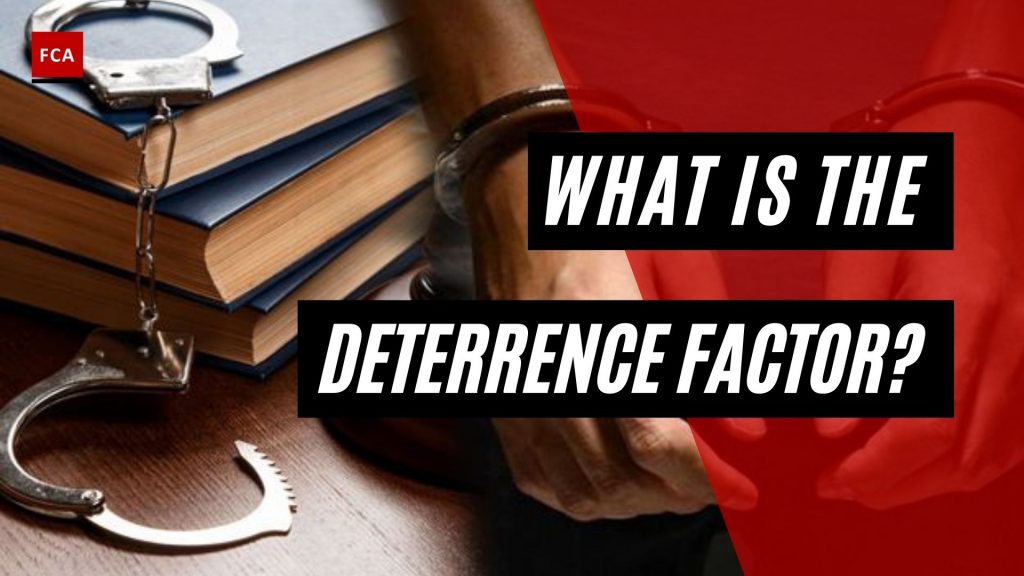The deterrence factor is considered as one of the most important behavioral approaches, which most of the fraudsters possess. This makes them feel bad about performing an act that may expose them to the public or make them face punishment not faced before.
The Deterrence Factor, representing the fear of punishment or societal disgrace, serves as a powerful tool in dissuading potential fraudsters, yet its effectiveness varies greatly based on individual risk assessment, severity of penalties, and effective communication of potential repercussions.
The Deterrence Factor
Is punishment effective in reducing crime? If so, in what way and to what extent? Deterrence, or the crime-prevention effects of the threat of punishment, is a choice theory in which individuals weigh the benefits and costs of crime.

Overview – What Deterrence Means
Deterrence is the embarrassment caused by the fear of punishment. Deterrence is considered the best way to stop fraud incidents before they occur, which may help in reducing financial, operational and reputational losses to the organization or a company.
Every company or organization develops internal processes and procedures to run the business and operational affairs through the employees.
The governance of the company or organization must approve such policies and procedures that lay down the punishments and fines related to the fraud incidents. These policies and processes aim to deter the occurrence of fraud incidents in the company. Such processes and procedures mention the levels of punishments or fines, which may be imposed on the employee or employees if a fraud incident is occurred or is reported to management. The level of punishments and fines vary based on the significance of fraud cases. These processes and procedures are required to be disseminated to the employees at all levels for their knowledge and compliance.
The Perception Of Detection
Fraud detection is based on the perception that fraud occurs where the environment and the conditions are suitable for it to occur. It is also important to understand that the fraudsters may cease committing the frauds when the net expected benefits from the fraudulent activities are outweighed by their expected punishments or costs.
It is also perceived that high financial punishments are more effective as compared to longer imprisonment. The person who is going to commit the fraud shall know that if he is caught after committing the fraud, the penalty amount is so significant that he or she may be required to sell off wealth to pay for the imposed punishment.
Fraud deterrence analysis could disclose possible fraud prospects in the process but is performed on the principle that taming a company’s internal procedures to condense or eliminate the factors of fraud is the single best defense against fraudulent activities. Fraud deterrence includes both short-term and long-term initiatives.
Deterrence also depends on the culprit’s evaluation of the risk involved in committing fraud. Some fraudsters may ignore the risks because of an overly optimistic state of mind about committing the fraud and irrational view about their ability to avoid its detection. Some fraudsters enjoy committing fraud and escaping detection. Such over-optimism and enjoyment behavior of the fraudsters must be considered and valued by the experts investigating the frauds.
Effectiveness Of The Deterrence Factor
It is difficult to measure and estimate the effects of criminal sanctions on subsequent criminal behavior. Despite numerous studies using a variety of data sources, sanctions, crime types, statistical methods, and theoretical approaches, there is little agreement in the scientific literature about whether, how, under what circumstances, to what extent, for which crimes, at what cost, for which individuals, and, perhaps most importantly, in which direction do various criminal sanctions work. There have been extensive reviews of the literature, with somewhat conflicting conclusions.
The Problem Of Communication
The motivating effect of criminal law is determined not by objective realities of law and law enforcement, but by the citizen’s subjective perception of these realities. A change that is not noticed has no impact. If we want to increase the deterrent effect in a particular field, for example, by imposing harsher sentences or increasing police activity, a critical question is whether people will be aware of the change. This aspect received little attention in classical deterrence theory. It appeared to be implicitly assumed that objective facts and subjective perceptions would agree.
Final Thoughts
The concept of deterrence rests on the idea that potential fraudsters, in the face of the potential embarrassment and punitive repercussions, will reconsider their actions to avoid significant consequences. Such an approach recognizes that fraud is often a choice made in a perceived opportune environment, an equation that changes when the anticipated costs or punishments outweigh the benefits. However, this deterrent approach does not exist in a vacuum and its effectiveness depends on several factors such as the severity and certainty of the punishment, the criminal’s personal risk evaluation, and the communication of these sanctions.
Although deterrence is a popular and logically appealing tactic, empirical validation of its effectiveness remains ambiguous and contentious. Moreover, individual perceptions, often divergent from the objective realities of sanctions, play a pivotal role, signaling the need for effective communication strategies to enhance deterrence. Therefore, while deterrence strategies hold promise, further research is needed to understand the specific conditions under which they work best, and how these can be consistently applied across different sectors and organizations.








